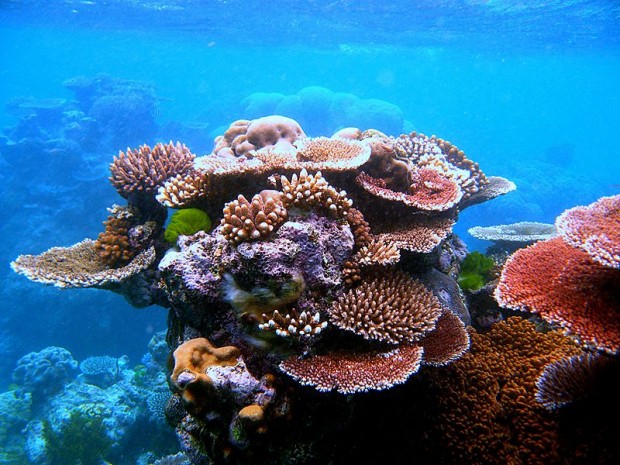Catlin Sponsors Great Barrier Reef Study
Bermuda-based Catlin Group Limited is sponsoring a major scientific expedition that will document the composition and health of sections of Australia’s Great Barrier Reef across an unprecedented range of depths before turning its attention to the Bermudian reef line.
The scientific data gathered by the Catlin Seaview Survey will strengthen the understanding of how climate change and other environmental changes are likely to affect ocean ecosystems like the Great Barrier Reef, said the survey’s science advisor, Professor Ove Hoegh-Guldberg of the Global Change Institute at The University of Queensland.
Part science project and part public outreach, the aim is to learn as much as possible about the reef’s state of health from a panoramic underwater photographic and video survey and let the rest of us enjoy the reef’s unparalleled beauty online.
“For the first time in history, we have the technology available to broadcast the findings of an expedition through Google. Millions of people will be able to experience the life, the science and the magic that exists under the surface of our oceans,” saidDr. Hoegh-Guldberg.
What the “New Scientist” magazine described as “an underwater variant of the Google Street View service” will also give web users an unprecedented photographic tour of a coral reef in Bermuda once work in Australia is completed. The Bermuda survey is expected to get underway in 2013.
A variety of corals on Flynn Reef, part of the Great Barrier Reef near Queensland, Australia:
Stephen Catlin, Chief Executive of Catlin Group Limited, said: “Catlin is sponsoring the Catlin Seaview Survey so that experts can obtain the objective scientific data they require to make more reliable conclusions about the impact of climate and environmental changes on our oceans and our planet as a whole. We’re proud to be part of the team leading this pioneering project.
“As an insurer, Catlin offers our clients protection against many types of risks, so it is natural that we should play a leading role in sponsoring research to learn more about the risks of tomorrow.”
The Catlin Seaview Survey, which will commence in September 2012, also aims to raise public awareness of potential changes to our planet’s oceans and underwater ecosystems, such as the Great Barrier Reef, by allowing everyone to engage with the survey via the internet.
The Catlin Seaview Survey camera, developed specifically for the expedition, will capture thousands of 360-degree underwater panoramas which, when stitched together, will allow people to choose a location, dip underwater and go for a virtual dive at all of the locations visited by the expedition.
Google is collaborating with the Catlin Seaview Survey and is working on a new feature on Panoramio [which links photos to locations], so that the 360-degree panoramic images can be uploaded and made available to millions of people worldwide.
Approximately 50,000 panoramas from the Catlin Seaview Survey will eventually be accessible on Google Earth and Google Maps. The project will also have a dedicated YouTube channel and the ability to broadcast ‘Hangouts’, which allows people to watch live streams of the expedition team from the ocean floor.
National Geographic video report on the Great Barrier Reef:
Professor Hoegh-Guldberg stressed that the visual nature of the project should help bridge the gap between scientific knowledge and public awareness. He said: “The Catlin Seaview Survey comprises a series of studies which will reveal to the public one of the last frontiers on Earth, the oceans.
“For the first time in history, we have the technology available to broadcast the findings of the expedition through Google. Millions of people will be able to experience the life, the science and the magic that exists under the surface of our oceans. This project is very exciting.”
The Catlin Seaview Survey will include three separate surveys: a shallow reef survey, a deep-water survey and a mega-fauna survey. Combined, these surveys will provide a baseline assessment of the composition, biodiversity and wellbeing of the Great Barrier Reef:
Shallow reef survey
The shallow reef survey will use a custom-designed underwater vehicle with a 360-degree camera to generate imagery of the reef. In collaboration with The University of Queensland, this will be assessed using image recognition software to enable a rapid visual census of corals, fish and many other organisms at 20 sites across the entire length of the 2,300km Great Barrier Reef. This will provide a broad-scale baseline for understanding climate change on coral reefs.
Deep-water survey
Using diving robots, the deep-water survey will explore the reef at depths of 30 to 100 metres. Little is known of the Great Barrier Reef at these depths, yet they may hold some of the secrets as to whether the coral reefs will survive rapid climate change. The survey will be conducted using a combination of high-definition cameras, deep-diving robots and survey equipment.
Mega-fauna survey
The mega-fauna survey team, led by Emmy Award-winning cinematographer and shark researcher Richard Fitzpatrick, will study the migratory behaviour of tiger sharks, green turtles and manta rays in response to increasing seawater temperatures. A total of 50 animals will be tracked with satellite tags that continuously monitor their geographic position, temperature and depth. This data can then be compared against oceanographic data to get a better understanding of the animal’s behaviour and migratory responses to the warming of the oceans.
Report On The Catlin Seaview Survey
Read More About
Category: All, Environment



Comments (1)
Trackback URL | Comments RSS Feed
Articles that link to this one: